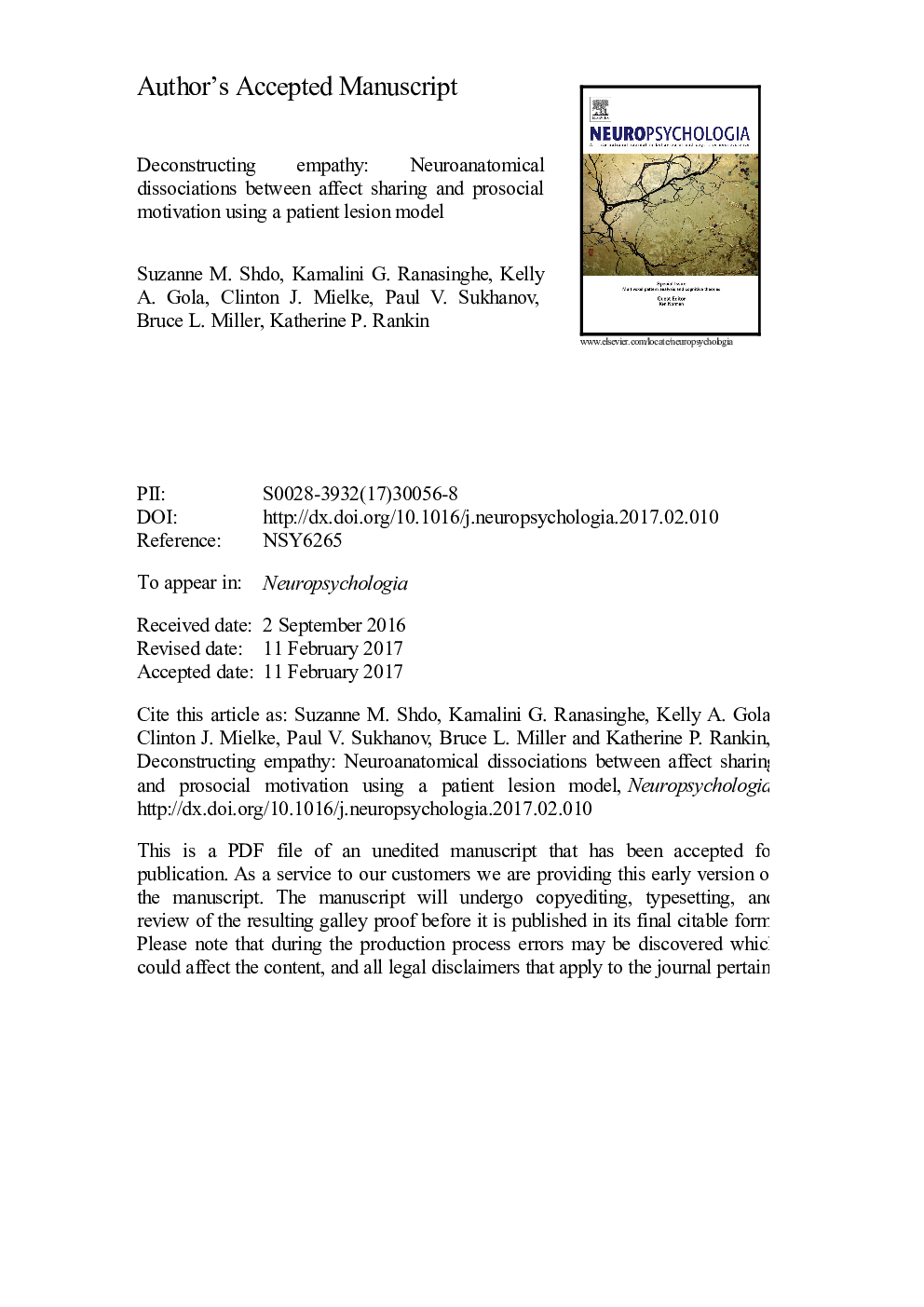| کد مقاله | کد نشریه | سال انتشار | مقاله انگلیسی | نسخه تمام متن |
|---|---|---|---|---|
| 8942280 | 1645068 | 2018 | 40 صفحه PDF | دانلود رایگان |
عنوان انگلیسی مقاله ISI
Deconstructing empathy: Neuroanatomical dissociations between affect sharing and prosocial motivation using a patient lesion model
ترجمه فارسی عنوان
همبستگی ساختگی: تشریح اعصاب و روان بین به اشتراک گذاری تأثیر و انگیزش حرفه ای با استفاده از یک مدل ضایعه بیمار
دانلود مقاله + سفارش ترجمه
دانلود مقاله ISI انگلیسی
رایگان برای ایرانیان
کلمات کلیدی
یکدلی، تأثیر اشتراکگذاری، انگیزه حرفه ای، مدل زخم، مورفومتری مبتنی بر وکسل، عصب مغزی
موضوعات مرتبط
علوم زیستی و بیوفناوری
علم عصب شناسی
علوم اعصاب رفتاری
چکیده انگلیسی
Affect sharing and prosocial motivation are integral parts of empathy that are conceptually and mechanistically distinct. We used a neurodegenerative disease (NDG) lesion model to examine the neural correlates of these two aspects of real-world empathic responding. The study enrolled 275 participants, including 44 healthy older controls and 231 patients diagnosed with one of five neurodegenerative diseases (75 Alzheimer's disease, 58 behavioral variant frontotemporal dementia (bvFTD), 42 semantic variant primary progressive aphasia (svPPA), 28 progressive supranuclear palsy, and 28 non-fluent variant primary progressive aphasia (nfvPPA). Informants completed the Revised Self-Monitoring Scale's Sensitivity to the Expressive Behavior of Others (RSMS-EX) subscale and the Interpersonal Reactivity Index's Empathic Concern (IRI-EC) subscale describing the typical empathic behavior of the participants in daily life. Using regression modeling of the voxel based morphometry of T1 brain scans prepared using SPM8 DARTEL-based preprocessing, we isolated the variance independently contributed by the affect sharing and the prosocial motivation elements of empathy as differentially measured by the two scales. We found that the affect sharing component uniquely correlated with volume in right>left medial and lateral temporal lobe structures, including the amygdala and insula, that support emotion recognition, emotion generation, and emotional awareness. Prosocial motivation, in contrast, involved structures such as the nucleus accumbens (NaCC), caudate head, and inferior frontal gyrus (IFG), which suggests that an individual must maintain the capacity to experience reward, to resolve ambiguity, and to inhibit their own emotional experience in order to effectively engage in spontaneous altruism as a component of their empathic response to others.
ناشر
Database: Elsevier - ScienceDirect (ساینس دایرکت)
Journal: Neuropsychologia - Volume 116, Part A, 31 July 2018, Pages 126-135
Journal: Neuropsychologia - Volume 116, Part A, 31 July 2018, Pages 126-135
نویسندگان
Suzanne M. Shdo, Kamalini G. Ranasinghe, Kelly A. Gola, Clinton J. Mielke, Paul V. Sukhanov, Bruce L. Miller, Katherine P. Rankin,
